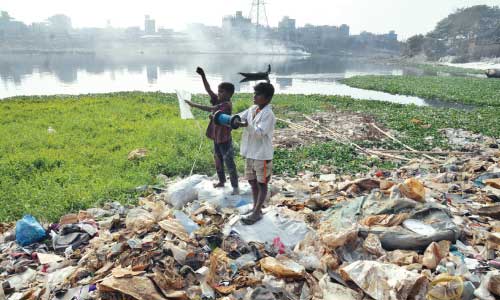Efforts to save Buriganga go in vain
Buriganga, once the main channel of communication between Dhaka city and the rest of the country, has virtually been reduced to a narrow channel of polluted slime with continued encroachment, flouting high court and government directives.
Buriganga’s aquatic environment is currently dead due to chronic pollution under the very nose of government agencies, said officials and experts.
Successive governments repeatedly vowed to save the river from encroachment and pollution but inevitably backed out when things have gone against the interests of vested quarters, said environmentalists.
‘It does not look like a river now as we can neither use the water nor can we take a dip, rather it looks like a large open drain passing through a city,’ said a local middle-aged boatman Salauddin at Shyambazar on Monday.
Toxic waste and sludge generated by textile, dyeing, printing, washing and pharmaceuticals industries, household and medical waste, sewage, dead animals, plastic and oil are also major pollutants of the river.
Some 21,000 cubic metres of untreated toxic waste are released every day from the Hazaribagh tanneries into the Buriganga River, according to a recent report of Poribesh Bachao Andolon.
‘To drink the water of Buriganga is totally out of question. One cannot even stand beside this river’s water due to the bad smell,’ said Bangladesh Inland Water Transport Authority chairman Commodore Mohammad Mozammel Haque.
On January 10 the industries minister Amir Hossain Amu gave a 72-hour ultimatum to tanneries at Hazaribagh to relocate to Savar, which was blatantly ignored.
BIWTA, under a one-year pilot project in 2010, extracted 8.44 lakh cubic meter waste from three kilometer riverbed of Buriganga (between Badamtali bridge and Hafijihujur Madrassha at Kamrangir char) and one kilometer of Turag river.
At the time, BIWTA had measured the waste to be 12 to 13 feet high on the riverbed.
A former senior project officer told New Age Sunday that on both sides of Buriganga about 700 industries, 12 markets, 1,100 families and 42 outlets of Dhaka’s two city corporations and Dhaka water supply and sewerage authority were dumping waste daily.
The Department of Environment collected samples from Buriganga river’s eight locations – Mirpur Bridge, Hazaribagh, Kamrangir Char, Chandni Char, Sadarghat, Dholaikhal, Bangladesh China Friendship Bridge and Pagla.
DoE River Water Quality Reports show that during the dry season (from January to May) the level of Dissolved Oxygen in Buriganga river was nearly nil at all points.
The reports also show that the level of Biochemical Oxygen Demand in river Buriganga was very high due to lack of dissolved oxygen.
Barisal University vice chancellor and soil, water and environment science expert professor SM Imamul Huq told New Age that aquatic life or biological environment inside the river was currently dead due to pollution.
In a landmark order in June 2009, the HC directed the government to restore Buriganga and three other rivers flowing by Dhaka by installing boundary pillars after evicting all illegal structures built by the encroachers upon the river.
During a recent visit to the river from Sadarghat to Postagola and Sadarghat to Ramchandrapur, it was found that numerous establishments had been built on the riverbank and many establishments were under construction through encroachment.
The encroachment of the river was widespread at Kamrangirchar and Basila area while at areas including Basila, Kamrangirchar, Kamalbagh and Islampur, local encroachers have raised concrete pillars with boundary walls.
Huge slums, shanties, dockyards and boat-building factories have also sprung up on both banks of the river.
Just opposite to Sadarghat terminal and many parts of the river at Keraniganj part, encroachers set up commercial establishments.
The second channel of Buriganga River was constantly encroached upon by different government agencies and local influential people at Kamrangirchar, Lalbagh and Rayerbazar killing field area.
Many encroachers had even erected sign boards advertising sale of plots inside the river on both banks in Kamrangirchar and Lalbagh areas.
‘Even after the High Court order the government did not take any strong initiative to free the river from all sorts of encroachments,’ said Sharif Jamil, joint secretary of Bangladesh Poribesh Andolon.
He said that the BIWTA sometimes conducted eviction drives against encroachment which was nothing but eyewash, as none of the big establishments on the riverbank have been evicted till date.
BIWTA and district administration in several drives from Sadarghat launch terminal to Shyambazar and Sadarghat terminal to Babubazar Bridge in this month evicted 125 illegal establishments and recovered 7.17 acres of land from the riverbank, said officials.
The BIWTA has established an eco-park at Shyampur by recovering the river land from encroachers and constructed a walkway from Shyampur to Fatulla.
Md Tofazzal Hossain Mia, deputy commissioner of Dhaka, said that in the last two years they conducted eviction drives from Postagala to Ramchandrapur of Buriganga River and three other rivers and recovered 135 bigha land.
‘But our efforts went in vain as many recovered land have been encroached again through lease or otherwise due to lax monitoring and conservation of the land by the BIWTA,’ he said.
Syeda Rizwana Hasan, chief executive of Bangladesh Environmental Lawyers Association, said that the government’s initiatives, those that had been taken under the pressure of the court to revive Buriganga River, remained only on paper.
DoE director (monitoring and enforcement) AKM Mizanur Rahman said they were regularly sending notice to the industries that dumped waste in Buriganga and fined them.
BIWTA chairman said from this year they had taken aggressive steps to evict grabbers from Buriganga river’s banks.
- See more at: http://newagebd.net/198333/efforts-to-save-buriganga-go-in-vain/#sthash.yyVUUQYI.dpuf











